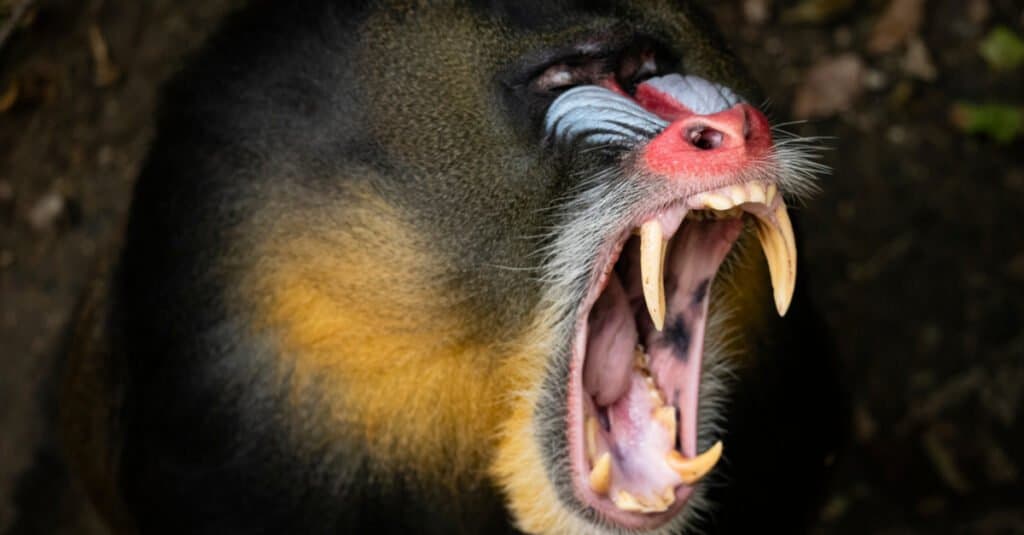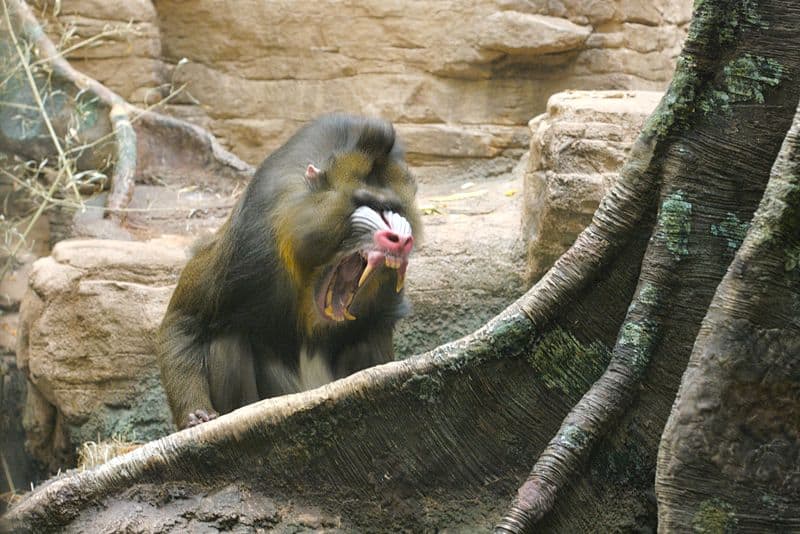One of the most stunning sights in the rainforest is the brightly colored and breathtaking mandrill. Closely resembling baboons, they are in fact the largest of the Old World monkeys. These impressive primates live in Equatorial Africa – particularly Cameroon, Gabon, Equatorial Guinea, and the Republic of the Congo. Along with their colorful features, mandrills are known for the large and fearsome looking teeth. But why are they so long and what makes them so important? Join us as we discover everything you need to know about mandrill teeth!
Mandrill Teeth

Mandrills have two sets of teeth in their life – milk teeth and 32 adult teeth
©Nikolay 007/Shutterstock.com
Mandrills are omnivores and their diet varies widely. They eat a range of fruit, leaves, seeds, insects, worms, snails, frogs, lizards and bird eggs. Mandrill are particularly unique as they even have cheek pouches that they fill with food to eat later. Just like many other animals, mandrills have two sets of teeth in their lifetime – a set of deciduous (milk) teeth, and a set of permanent teeth. Mandrills have deciduous incisors, canines, and premolars, but their molars are present only in their adult set of teeth. They have their complete set of milk teeth by the time they are five months old and their adult teeth begin to erupt at around 26 months.
Mandrills have 32 adult teeth in total which consist of eight incisors, four canines, eight premolars, and twelve molars. Male mandrills have their complete set of adult teeth at around five and a half years old, while females have all of their adult teeth by 8 years of age. However, the age of tooth eruption of certain teeth differs between males and females. The first molars and the incisors erupt earlier in females than in males, but the last molars erupt later.
The most distinctive teeth that mandrills have are their large canine teeth. They have four canine teeth – one on each side of both their upper and lower jaw. The canines are curved and incredibly sharp and pointed. The upper canine teeth have noticeable deep grooves in them which are wider at the top of the tooth. The upper canines of males extend down well past the lower canines, and can be up to 2.5 inches long.
Do Males have Bigger Teeth than Females?
Mandrills are one of the most sexually dimorphic animals in the world and they exhibit strong sexual selection which favors the males in both size and color. Sexual selection is when selection of a mate occurs due to preference by one sex due certain characteristics in the other sex. When this happens, the animal with the characteristics that are preferred automatically has an advantage over those that don’t and get more mating opportunities. In the case of mandrills, the males are typically twice the weight of females and are generally more brightly colored. Indeed, the dominant male is the most brightly colored of the group, and only the brightest and most dominant males ever father offspring.
But how does all of this relate to their teeth? Well, mandrills also exhibit dental sexual selection and all of their teeth are sexually dimorphic in size. This means that male mandrills have bigger teeth than female mandrills. It is believed that most of their teeth are larger as a result of selection for the efficiency at chewing and processing food. This in turn converts to energy quicker and more effectively for the larger animals.
Canines

Mandrills teeth can reach 2.5 inches long
©Maciej Kopaniecki/Shutterstock.com
Although all male mandrill teeth are larger than females, their important sexually dimorphic teeth are their canines. The size difference between male and female mandrill teeth is most evident in the canines. The canines of male mandrills reach 2.5 inches, while females usually only reach between 0.5 and 1 inches long.
The length of the male canines is an important factor in reproduction. Studies have shown that male mandrills only sire offspring when their canines are longer than 1.5 inches long – or two thirds of their eventual adult length of 2.5 inches.
One of the most interesting aspects of male mandrill teeth is how their length affects their reproductivity over time. Male mandrill canines wear away over time as the animal ages. Studies have shown that this affects their dominance and ability to reproduce. Just like how they can only father offspring once their canines are more than 1.5 inches long, their optimum reproductivity is when their canines are at their longest. Eventually, as they age and their teeth wear down their dominance and reproductivity wanes. Not only that, but at the same time the brightness of their colors fade as they become less dominant too.
At least part of the relationship between male canine teeth and the ability to reproduce is thought to be because of the role of the canine teeth as weapons. Sometimes male mandrills fight for dominance and when this happens the fights can be deadly. Inevitably, the large and impressive canines are used in the fight and are certainly capable of inflicting some serious damage. Scientists believe that sexual selection has worked to hone the canine teeth as weapons of the male mandrills and also to provide males with the largest teeth for mating purposes.
What’s that Face they Pull?

Mandrills display their teeth as a greeting or as reassurance – known as a silent bared teeth display
©Ryan E. Poplin / Creative Commons
If you’ve ever seen a mandrill then you might have noticed that they sometimes pull a face where they show their teeth. You might have even thought that they were baring their teeth as a sign of aggression. In fact, it’s actually something known as a “silent bared teeth display” and is a relatively peaceful gesture.
The silent bared teeth display in mandrills involves them pulling back their lips and showing their teeth. Sometimes their head crest is stood up and they are shaking their heads while baring their teeth. Most of the time the jaw is closed which is known as a closed bared teeth display. However, sometimes the jaw can be open which is known as an open bared teeth display. With male mandrills their lips are drawn back far enough that their large canines and their premolars are showing. Although it looks as though they’re baring their teeth as a warning or in preparation for an attack, it’s usually the complete opposite. This display of teeth is actually a form of communication. It is often used as a greeting or as a reassuring expression after any form of threat.
The photo featured at the top of this post is © Maciej Kopaniecki/Shutterstock.com
Thank you for reading! Have some feedback for us? Contact the AZ Animals editorial team.







